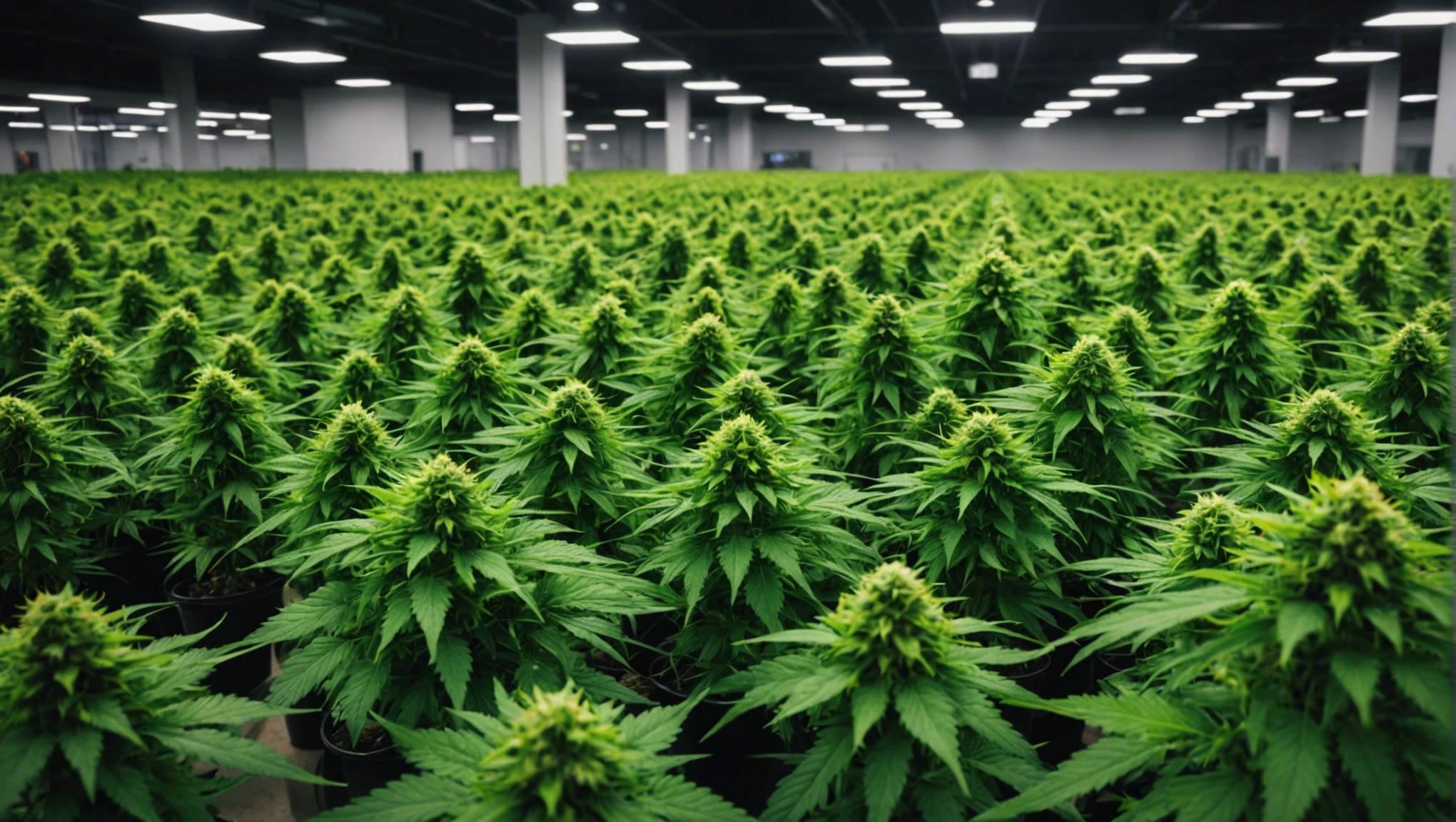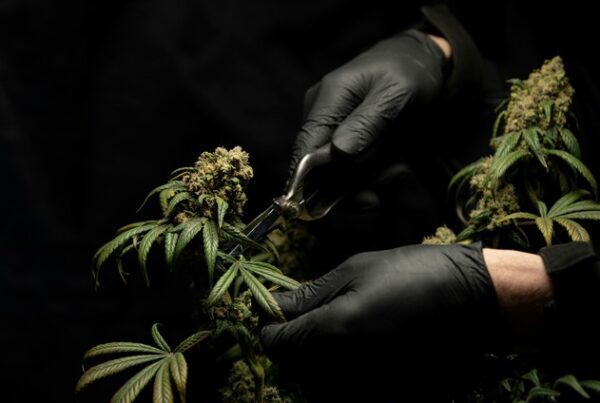
The future of cannabis cultivation is rapidly evolving with innovations and trends focusing on growing high-THC strains. As the cannabis industry continues to expand and gain acceptance, cultivators are exploring new techniques and technologies to enhance the quality and potency of their products. From advanced breeding methods to sustainable growing practices, the landscape of cannabis cultivation is being reshaped. This shift is not only driven by consumer demand for potent strains but also by the increasing legalization and regulation of cannabis in various regions. In this dynamic environment, staying ahead of the curve is crucial for cultivators looking to thrive in the competitive market. This introduction will delve into the latest developments in cannabis cultivation, highlighting key innovations and trends that are shaping the future of growing high-THC strains.
Genetic Engineering and Strain Development
Genetic engineering has revolutionized the cannabis industry, particularly in the development of high-THC strains. By employing techniques such as gene editing and modification, researchers and breeders can enhance the cannabinoid profile of cannabis plants, resulting in strains with elevated levels of THC. This advancement has not only catered to the recreational market but also to the medical sector where specific cannabinoid ratios are crucial for therapeutic purposes.
Moreover, genetic engineering has significantly impacted cannabis cultivation efficiency and customization. Through targeted genetic modifications, cultivators can improve traits such as yield, pest resistance, and flowering time. This level of precision allows for the creation of strains that are better suited to specific growing conditions or consumer preferences. As a result, genetic engineering has opened up new possibilities for the cannabis industry, driving innovation and pushing the boundaries of what is achievable in strain development.
In addition to THC levels, genetic engineering can also be used to manipulate other cannabinoids present in cannabis plants. For example, researchers have been able to increase the levels of CBD, a non-psychoactive cannabinoid with various potential therapeutic benefits. This ability to tailor cannabinoid profiles extends beyond just THC, offering a wide range of possibilities for creating strains with specific medicinal properties.
Furthermore, genetic engineering allows for the development of cannabis plants with enhanced terpene profiles. Terpenes are aromatic compounds found in cannabis that not only contribute to the plant’s aroma and flavor but also offer potential synergistic effects with cannabinoids, known as the entourage effect. By modifying the genes responsible for terpene production, breeders can create strains with unique and desirable scent profiles, enhancing the overall consumer experience.
The advancements in genetic engineering have also led to increased sustainability in cannabis cultivation. By developing strains that require fewer resources such as water and nutrients, breeders can help reduce the environmental impact of cannabis production. Additionally, genetic modifications can enhance the plant’s natural defenses against pests and diseases, reducing the need for chemical pesticides and promoting eco-friendly growing practices.
Overall, genetic engineering plays a crucial role in the ongoing evolution of the cannabis industry. From creating high-THC strains to customizing cannabinoid and terpene profiles, the possibilities are vast. As technology continues to advance, we can expect further innovations in strain development that cater to both recreational and medicinal users, ultimately shaping the future of cannabis cultivation.
Terpenes and Cannabinoids: Unveiling the Intricacies
Terpenes are not only aromatic compounds found in various plants, including cannabis, but they also play a significant role in the entourage effect, where cannabinoids and terpenes work together synergistically to enhance the overall therapeutic effects of the plant. The vast terpene diversity in cannabis, with over 100 different terpenes identified, offers a wide range of potential benefits beyond just aroma and flavor. For example,. myrcene , commonly found in cannabis, is known for its sedative properties, while. limonene May have mood-enhancing effects. Understanding these terpene profiles can help consumers choose strains that better suit their desired experiences.
Terpene Influence on Cannabinoids
Moreover, terpenes are not just passive contributors; they can also influence how cannabinoids bind to receptors in the endocannabinoid system, potentially altering the overall effects of the strain. This intricate interplay between terpenes and cannabinoids underscores the importance of considering more than just THC and CBD content when selecting cannabis products.
Rising Demand for Exotic Cannabinoid Profiles
As consumer awareness grows, there is a rising demand for exotic cannabinoid profiles that go beyond the usual suspects. Cannabinoids like. CBC ,. CBG , and. CBN Are gaining attention for their potential therapeutic properties, ranging from anti-inflammatory effects to neuroprotective qualities.
Exploration of Minor Cannabinoids
The exploration of these minor cannabinoids opens up new possibilities for tailored cannabis experiences that target specific health concerns or desired effects. Cultivators and manufacturers are increasingly focusing on breeding techniques that enhance these lesser-known cannabinoids, creating a diverse array of products to cater to evolving consumer preferences.
Diverse Terpene Profiles
Beyond the well-known terpenes like myrcene and limonene, other terpenes such as. terpinolene ,. pinene , and. caryophyllene Are gaining attention for their unique effects. Terpinolene, with its floral and herbal aroma, is believed to have antioxidant and sedative properties, adding another layer of complexity to the entourage effect. Pinene offers a pine-like scent and may aid in respiratory function, making it a sought-after terpene for potential respiratory benefits. Caryophyllene, found in black pepper and cloves, not only contributes to the spicy and peppery notes in some cannabis strains but also interacts with the endocannabinoid system, potentially offering anti-inflammatory effects.
Emerging Cannabinoids
In addition to the growing interest in minor cannabinoids like CBC, CBG, and CBN, newer cannabinoids such as. THCV And. delta-8-THC Are emerging in the market, each with its own unique properties and potential benefits. THCV is known for its appetite-suppressing and energizing effects, making it a focal point for weight management and focus-enhancing products. Delta-8-THC, a milder psychoactive compound than delta-9-THC, is gaining popularity for its purported anxiety-reducing and anti-nausea properties.
Unlocking the Full Potential
By embracing terpene diversity and cannabinoid trends, both consumers and industry professionals can unlock the full spectrum of benefits that the cannabis plant has to offer, paving the way for a more nuanced and personalized approach to cannabis consumption and well-being.
Technological Advancements in Cannabis Cultivation
With the increasing legalization of cannabis in various regions, the cultivation industry is witnessing a technological revolution. One of the key advancements is the implementation of cloud-controlled lights and IoT technology. By using sensors and automated systems, growers can create optimized growth conditions for their plants, ensuring the right amount of light, water, and nutrients are provided at all times. This level of precision helps in maximizing yields and maintaining consistent quality.
Another significant development is the use of big data and analytics in strain development and production efficiency. By collecting and analyzing data on plant genetics, environmental conditions, and cultivation techniques, researchers can identify patterns that lead to the creation of new and improved cannabis strains. Additionally, data-driven insights help cultivators streamline their operations, reduce waste, and increase overall productivity. These technological advancements not only benefit growers by enhancing crop quality and quantity but also contribute to the ongoing innovation within the cannabis industry.
In addition to cloud-controlled lights and IoT technology, advancements in automation have also revolutionized cannabis cultivation. Automated systems for tasks such as watering, nutrient delivery, and climate control have significantly reduced the labor required for cultivation while ensuring precise and consistent care for the plants. This automation not only increases efficiency but also minimizes human error, leading to higher crop yields and improved quality.
Furthermore, the integration of artificial intelligence (AI) in cannabis cultivation is gaining traction. AI algorithms can analyze vast amounts of data to predict optimal growing conditions, detect plant diseases at early stages, and even suggest customized nutrient plans based on individual plant needs. This level of personalized care enhances plant health and overall crop output.
Moreover, advancements in sustainable cultivation practices are becoming increasingly important in the cannabis industry. Growers are exploring eco-friendly solutions such as water recycling systems, renewable energy sources, and organic pest control methods to reduce environmental impact and promote sustainability. By adopting these practices, cultivators not only contribute to a greener future but also meet the growing consumer demand for ethically produced cannabis products.
Overall, the convergence of technology, data analytics, automation, AI, and sustainability practices is reshaping the landscape of cannabis cultivation. These advancements not only drive efficiency and innovation within the industry but also pave the way for a more sustainable and high-quality cannabis market.
The Future of Cannabis Cultivation: A Revolution in the Making
The future of cannabis cultivation is on the brink of a revolution, driven by the convergence of precision agriculture and gene editing technologies. This dynamic shift towards more sustainable and efficient cultivation practices is reshaping the landscape of the cannabis industry, paving the way for innovative advancements and novel discoveries.
Precision Agriculture: Redefining Cultivation
Precision agriculture, characterized by its data-driven approach, is redefining how cannabis is grown and managed. By leveraging cutting-edge tools such as AI-powered analytics, remote sensing technologies, and robotic systems, cultivators can monitor and optimize every aspect of the cultivation process with unprecedented accuracy. From precise nutrient delivery to automated pest management, these technologies empower growers to maximize crop yields, minimize resource wastage, and ensure consistent product quality.
Gene Editing and Modern Genomics: Unlocking Potential
In parallel, the role of gene editing and modern genomics in cannabis cultivation cannot be overstated. With the ability to precisely manipulate the plant’s genetic code, researchers are unlocking a treasure trove of possibilities for developing cannabis strains with tailored characteristics. By targeting specific genes responsible for cannabinoid synthesis, terpene production, and stress tolerance, scientists can create cultivars that exhibit enhanced potency, unique flavor profiles, and increased resilience to environmental challenges.
Future Implications: Healthcare and Beyond
Furthermore, the intersection of gene editing and medicinal cannabis holds immense promise for the healthcare industry. By engineering cannabis varieties with optimized cannabinoid ratios and targeted therapeutic properties, researchers are pioneering new treatments for a wide range of medical conditions, from chronic pain management to neurological disorders.
Embracing Innovation: The Path Forward
As we look ahead, the future of cannabis cultivation lies in the seamless integration of precision agriculture practices and advanced genetic technologies. This synergy between data-driven decision-making and genetic innovation not only ensures sustainable production methods but also drives the development of next-generation cannabis products that cater to evolving consumer preferences and medical needs. Embracing this transformative era of cultivation is key to unlocking the full potential of cannabis and propelling the industry towards a future defined by excellence, sustainability, and scientific ingenuity.
Consumer Demand and Curative Qualities
In recent years, there has been a significant uptick in consumer demand for cannabis strains that exhibit curative properties. This shift in consumer behavior can be attributed to the growing recognition and acceptance of the potential health benefits associated with specific cannabis strains. Consumers are actively seeking out strains that not only offer recreational effects but also therapeutic benefits, such as alleviating pain, reducing anxiety, and enhancing sleep quality.
Moreover, the impact of scientific and technological advancements on strain development is profound. Ongoing research has enabled breeders to delve deeper into the chemical composition of various strains and understand how these compounds interact with the human body. This deeper understanding has facilitated the targeted breeding of strains with precise curative qualities, meeting the evolving demands and preferences of consumers.
The convergence of consumer demand and scientific progress is propelling the cannabis industry towards the creation of strains with increasingly potent curative properties. This trend is reshaping the landscape of cannabis consumption, with a growing emphasis on wellness and therapeutic applications.
As consumer awareness continues to expand, there is a parallel surge in research dedicated to unlocking the full potential of cannabis as a medicinal resource. This synergy between consumer demand and scientific exploration is fostering a new era of strain development, where the focus is not only on potency but also on tailored effects that cater to specific health needs.
The intersection of consumer demand for curative cannabis strains and the advancements in scientific understanding is driving a paradigm shift in the industry. The future holds promise for a diverse array of strains that not only offer recreational enjoyment but also serve as natural remedies for various health conditions, marking a transformative phase in the evolution of cannabis culture.
The increasing interest in cannabis strains with curative properties has also led to a rise in specialized dispensaries and wellness centers that focus on providing education and access to these strains. Consumers are becoming more discerning, seeking out information on cannabinoid profiles, terpene content, and cultivation methods to ensure they are selecting products that align with their specific health goals.
Furthermore, the legalization of cannabis for medical purposes in many regions has opened up avenues for clinical trials and research studies exploring the efficacy of different strains in treating specific medical conditions. This scientific validation is crucial in further legitimizing the use of cannabis as a therapeutic agent and expanding its acceptance within the medical community.
In addition to the physical health benefits, there is a growing recognition of the mental health benefits that certain cannabis strains can offer. Strains high in CBD (cannabidiol) and low in THC (tetrahydrocannabinol) have gained popularity for their anxiolytic and mood-stabilizing properties, providing a natural alternative for individuals seeking relief from conditions such as anxiety, depression, and PTSD.
Overall, the intersection of consumer demand, scientific innovation, and regulatory changes is driving a renaissance in the cannabis industry, where the focus is shifting towards holistic wellness and personalized medicine. The future of cannabis cultivation lies in the continued collaboration between researchers, breeders, and consumers to unlock the full potential of this versatile plant in addressing a wide range of health and wellness needs.
Global Trends and Legal Implications
In recent years, there has been a significant shift in global attitudes towards cannabis production, trade, and consumption. Countries around the world are reevaluating their stance on cannabis, leading to various legal changes that have far-reaching implications.
One of the key trends is the increasing acceptance of cannabis for both medicinal and recreational use. This shift has led to a booming industry with a focus on innovation in cultivation techniques, product development, and distribution channels.
Furthermore, the legalization of cannabis in many regions has not only impacted the industry but also influenced agricultural practices. Farmers are exploring new cultivation methods and technologies to meet the growing demand for cannabis products.
On the consumer side, the legal changes have also sparked interest in home cultivation. Many individuals are now legally allowed to grow their cannabis plants, leading to a rise in DIY cultivation setups and a demand for educational resources on best practices.
These global trends and legal implications highlight the evolving landscape of the cannabis industry and the need for stakeholders to stay informed and adapt to the changing regulatory environment.
Moreover, the global cannabis market is witnessing a surge in investment and research. As more countries legalize cannabis in various forms, the market is projected to experience exponential growth. This growth is not only limited to traditional cannabis products but also extends to the development of new cannabis-based pharmaceuticals and wellness products.
The legal changes have also prompted discussions on social justice and equity within the cannabis industry. Many advocates argue for the expungement of past cannabis-related convictions and the inclusion of marginalized communities in the emerging market.
In addition to the economic and social impacts, the global trends in cannabis have sparked debates on international trade regulations and standardization of quality control measures. As cannabis products cross borders, ensuring consistency in quality and potency becomes a critical issue for regulators and industry players.
Overall, the evolving global trends in cannabis production, trade, and consumption are reshaping the industry on a global scale. Stakeholders need to navigate the complex legal landscape, embrace innovation, and address social and ethical considerations to thrive in this dynamic environment.
The future of cannabis cultivation is undoubtedly heading towards innovative practices and trends that cater to the growing demand for high-THC strains. As we explore faster and more efficient ways to cultivate cannabis, the emergence of fast flowering weed seeds stands out as a game-changer in the industry. These seeds not only offer quicker harvests and enhanced crop management but also provide a diverse range of unique cannabis experiences for consumers.
To delve deeper into the realm of fast flowering strains and unlock their full potential, visit. JG Seeds For valuable insights on cultivation techniques, notable strains, and the benefits they bring to both growers and consumers. Embrace the future of cannabis cultivation with fast flowering seeds and elevate your growing experience to new heights.










